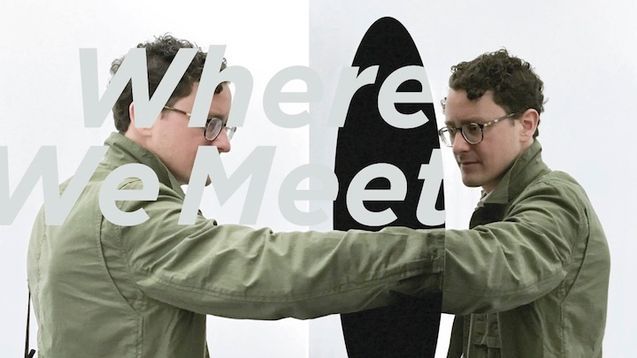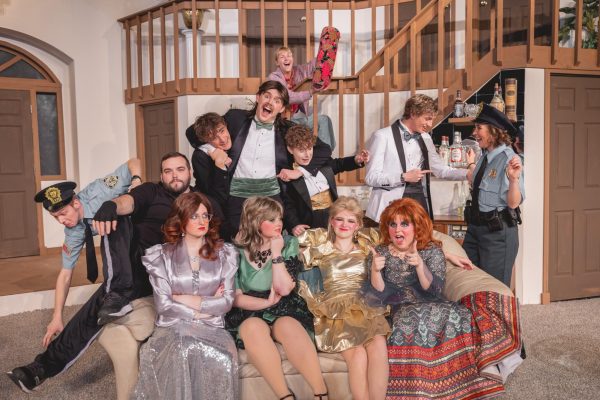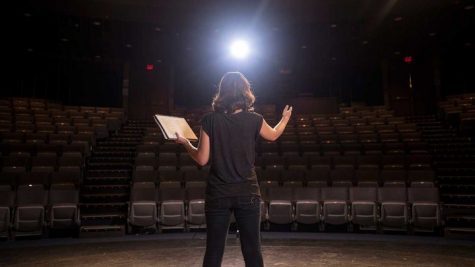“Where We Meet” forces introspection
The new exhibit will be in the Center Art Gallery until Dec. 14.
With his avant-garde exhibit “Where We Meet,” now being shown at the CFAC Center Art Gallery, David Wallace Haskins wants his audience to meet themselves. While we might see ourselves in the mirror every day, Haskins forces the observer to really think about who’s staring back at us through the glass by taking us through four different pieces.
The title piece, the first thing you see walking into the exhibit, is a projection. As you watch, three small dots appear in the black void of the wall. Soon, the dots become people walking towards you. Male and female. Young and old. They stroll up slowly to the viewer, becoming life-sized. Then, they just stop and stare at you. Perhaps they’ll smile at you or display no emotion. Maybe they’ll fidget with their clothes or hair or stay still as a statue. Whatever the case, eye contact is never broken.
The effect is off-putting; you’re making eye-contact with a person who technically can’t see you. They feel like they’re there, even though they’re just flat images on a wall. This blend of connection and disconnection forces a strange kind of self-examination on the observer. What would these people think of how I’m looking at them? What would I think of them in person?
The other pieces in the exhibit, however, take self-reflection literally. “Void Mirror,” the next display, is an otherwise normal mirror with a hole of black neatly cut out of the center. It’s less of a piece that tells you something and more like a prompt asking you to think about what that hole is in your own life.
The same cannot be said for “Mirror Monolith,” a piece which evokes ideas about the equality of humanity. The mirror is tall and thin, only wide enough to capture the viewer within its frame. However, were you to have a friend step behind the mirror you would find yourself staring at them face-to-face in yet another move seemingly made to make the observer uncomfortable. “Mirror Monolith” is a transparent construction where the only other thing to look at other than your reflection is the person on the other side being overlapped by said reflection. It’s a unique execution when exploring the unity of humanity: literally having your reflection be that of another person.
The fourth and final piece is the “Time Mirror.” When first walking into the walled-off area you might be confused when you see what appears to be a live video feed of the room. According to whatever is recording the footage, though, you’re not there. That is until about seven seconds later you see yourself walking through the doorway and watch as your past self becomes confused by their lack of appearance on-screen.
Whereas Haskins has used disconnection in the previous pieces through use of transparency, an incomplete picture and uncomfortable intimacy, here he separates the audience from themselves through the use of time. Seeing yourself do something seven seconds after you already did it gives you the feeling that you’re watching somebody else entirely. Because the sense is “I’m watching somebody else” it can reveal what our habitual thoughts are when sizing up other people. If you watch somebody do a silly dance, are you thinking, “They look like fun” or “What is that idiot doing?” And since you’re the one doing it, what does that response say about your own self-image?
Honest self-critique is uncomfortable. It has neither the self-pity of isolating our negatives nor the pride of cherry-picking our positives. To lay yourself out in full and realize, “This is who I am,” is the last thing anybody wants to do. And yet, if we’re to be the people we’re meant to, it’s a necessary process. “Where We Meet” is an extraordinary, necessary discomfort; one you probably can’t find anywhere else.06








Edie Veenstra Richardson • Dec 8, 2019 at 3:15 am
This sounds like a very thought provoking exhibit. Fascinating concepts in the first place, then executing them in such a way that goes against the norm just enough to make each successive piece enticing. Do I have that right? Wonderful article. Kinda tickles the curiosity to come see it in person. Thanks for writing about it.
Carol Christenson • Dec 6, 2019 at 8:36 am
Fascinating perspective!